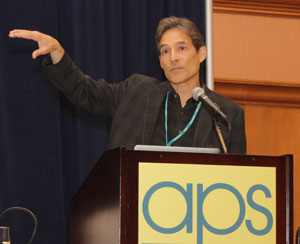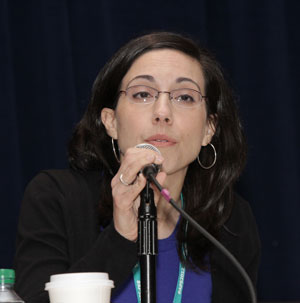A Glimpse Inside the Brains of Trauma Survivors

George A. Bonanno was lead author of a 2010 Psychological Science in the Public Interest report on disaster and recovery.
As psychological scientists’ understanding of traumatic events improves, so might the psychological outcomes of people who endure trauma. That hopeful thread connected the talks in the “Disaster, Response, and Recovery” theme program at the 24th APS Annual Convention.
“Most people are exposed to what we consider traumatic events at least several times in their life,” said George Bonanno of Columbia University, who set the tone for the program with a question. “Is disaster psychologically harmful to everyone?”
Bonanno has demonstrated through statistical modeling that humans are actually quite resilient in the face of disastrous events. While disasters can cause major psychological trauma that can’t be fixed with a quick and easy solution, over time most people demonstrate an impressive ability to rebound from a frightening incident.
Data over the years have revealed four patterns of response to traumatic events, Bonanno said. The most severe is chronic dysfunction, often manifesting as posttraumatic stress disorder (PTSD), which typically affects 5 to 30 percent of those involved in a disaster. Up to 25 percent of people display a recovery response, with another 15 percent showing a delayed stress response.
The most common response is actually resilience, Bonanno said. Roughly 35 to 65 percent of people who experience a disaster return to their normal routine shortly after the event and stay there. A recent study of war veterans, for instance, not only demonstrated that roughly 7 percent of soldiers who were deployed developed PTSD, but that 83 percent showed exemplary mental health in the face of potentially traumatic combat situations.

Silvia H. Koller shares results from a study of at-risk youth in Brazil. The findings “shed light on the extent to which protective factors may ameliorate exposure to risk.”
Recent research has shown that resilience has also been the most common documented response to events such as a nightmare mudslide in Mexico or the 9/11 attacks. The prevalence of resilience suggests it stems from many sources.
“We tend to think there’s one or two things that can make people resilient,” said Bonanno. “That’s probably not the case.”
Silvia Koller of Rio Grande do Sul Federal University in Brazil, studies the concept of resilience as it applies to her native country. While Brazil has the eighth largest economy in the world, the country continues to struggle with extreme income inequality, a history of military rule, problematic education and health systems, and heavy violence in certain regions. At the same time, said Koller, Brazilians have a strong will for change, as well as powerful family systems and community programs.
Koller recently conducted a large study of impoverished youths in a number of Brazilian cities and their experiences with trauma. Using self-report questionnaires from more than 5,200 14- to 24-year-olds, Koller and colleagues documented risk exposure (such as domestic problems, economic struggles, and community violence) and markers of maladjustment (such as drug use, delinquency, sexual risk-taking). They also measured potentially protective factors like school attachment, self-efficacy, and family support.
The researchers found a strong link between risk-exposure and maladjustment, but they also found that protective conditions mitigated the negative effects of this relationship. Promoting these positive social elements might increase resilience even among a very disadvantaged population, Koller said.

There’s some indication that certain brain activation, particularly in the amygdala, could predict treatment response, says Lisa M. Shin.
“Our results indicate that risk factors were positively associated with maladjustment, but psychosocial protective factors diminish that association,” she said. “It gives some hope that we can work on protective factors to better the life of those youth.”
Psychological scientists have also learned much about traumatic responses through imaging technology — especially about PTSD, reported Lisa Shin of Tufts University. Shin and her colleagues use functional brain scanners to measure brain activity at rest and then take measurements again when participants are reminded of traumatic events.
The researchers in Shin’s lab, as well as others in the field, have observed greater activation of the amygdala (which detects threats) and the dorsal anterior cingulate cortex (a fear-mediation center) in people who suffer from PTSD. They’ve also found lower activation of the medial prefrontal cortex/rostral anterior cingulate cortex, an area involved in fear extinction, in these same populations.
“Extinction is the process of learning that the thing that used to predict threat no longer predicts threat,” Shin said. “You need to have an intact medial prefrontal cortex in order for extinction learning — and especially extinction memory — to occur normally.”
The good news, said Shin, is that psychological scientists are starting to find evidence that certain treatments can rehabilitate brain abnormalities associated with PTSD. For instance, some research has shown that cognitive behavioral therapy can increase activity in the rostral anterior cingulate cortex — perhaps a sign that the ability to learn when threats have abated is growing stronger among patients.

“We have to create new instruments to understand our complexworld — to understand interactions,” says Dirk Helbing.
The program’s final speaker, Dirk Helbing of the Swiss Federal Institute of Technology in Zurich, spoke beside a large tower of cardboard boxes, which he cautioned anyone in the audience who “likes to talk to lawyers” not to sit near. Helbing, who is a sociologist rather than a psychological scientist, uses a physics-based approach to understand the complicated behavioral interactions that govern the world.
“Society obviously is a complex system, and it requires a combination of many different sciences to understand,” he said.
Helbing is affiliated with the FuturICT project — an effort to understand the role that information communication technologies (ICT) play in cultural networks. The ultimate goal of FuturICT is to manage human resilience in the face of social problems and to develop new instruments for evaluating behavioral interactions that occur around the world.
One of these instruments is called the “planetary nervous system,” an online dataset that can reveal a picture of global social and economic networks in real time. The system could potentially detect instabilities in social capital and provide a tool for policy makers to confront these weaknesses before disasters occur. Helbing believes the disappearance of trust, for instance, played a role in the recent financial collapse.
“In order to make society more resilient, we need to overcome barriers to conventional thinking,” concluded Helbing, who then stepped off the podium and burst through the tower of boxes — and emerged unscathed.
Watch more at: www.youtube.com/psychologicalscience





APS regularly opens certain online articles for discussion on our website. Effective February 2021, you must be a logged-in APS member to post comments. By posting a comment, you agree to our Community Guidelines and the display of your profile information, including your name and affiliation. Any opinions, findings, conclusions, or recommendations present in article comments are those of the writers and do not necessarily reflect the views of APS or the article’s author. For more information, please see our Community Guidelines.
Please login with your APS account to comment.